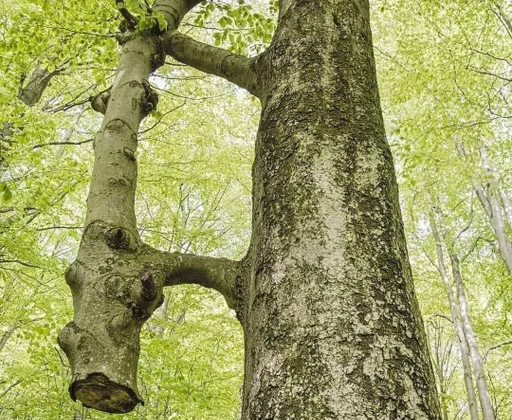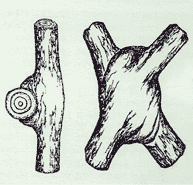

Inosculation is a natural phenomenon in which trunks, branches, or roots of two trees grow together in a manner biologically similar to the artificial process of grafting. The term is derived from the Latin roots in + ōsculārī, which means “to kiss inward/into/against,” or more illustratively, “to make a small mouth inward/into/against.” Trees that have undergone this process are referred to as gemels in forestry, which comes from the Latin word meaning “a pair.”
It is most common for branches of the same species of two trees to grow together, although inosculation may occur across related species. Initially, the branches grow separately in proximity to each other until they touch. At this point, the bark on the touching surfaces is gradually abraded away as the trees move in the wind. Once the cambium of two trees touches, they can self-graft and grow together as they expand in diameter. Inosculation usually occurs when tree limbs are braided or pleached.
The term inosculation is also used in the context of plastic surgery as one of the three mechanisms by which skin grafts take at the host site. Blood vessels from the recipient site connect with those of the graft to restore vascularity.

Species
Inosculation is most common among the following taxa due to their thin bark:
| Taxa | Commonality of Inosculation |
|---|---|
| Apple | High |
| Almond | High |
| Ash | High |
| Beech | High |
| Crepe myrtle | High |
| Chestnut | High |
| Dogwood | High |
| Elm | High |
| Ficus | High |
| Grape | High |
| Hazelnut | High |
| Hornbeam | High |
| Laburnum | High |
| Linden | High |
| Maple | High |
| Norway spruce | High |
| Olive | High |
| Peach | High |
| Pear | High |
| Privet | High |
| River red gum | High |
| Sycamore | High |
| Willow | High |
| Wisteria | High |
Conjoined trees
Inosculation is a natural process in which two trees grow together and conjoin, even if they are of different genera or families. They may appear to be grafted together, but usually, grafting only occurs between two trees of the same or closely related species or genera. Trees can become conjoined when they are physically touching, rubbing, intertwined, or entangled. Once the cambium of two trees touches, they self-graft and grow together. Both conifers and deciduous trees can become conjoined. Beech trees and blackthorn, in particular, are frequent conjoiners.

These trees are often colloquially referred to as “husband and wife” trees or “marriage trees.” The term is derived from the obvious unification of two separate individual trees, although it can also have a humorous connotation relating to the sexually suggestive appearance of some natural examples. In some cases, there may be a religious intent behind the term, as some cults are organized around beliefs that trees contain a hidden or sacred power to cure or enhance fertility, or that they contain the souls of ancestors or the unborn.
Examples
At the ruined Lynncraigs Farm in Dalry, North Ayrshire, Scotland, a blackthorn (Prunus spinosa) standing in the old farm garden shows signs of deliberate grafting.
During his Tour of Scotland, published in 1800, T. Garnett noted a tree near Inveraray that locals called the Marriage tree. It was formed from a lime tree with two trunks joined by a branch, resembling a person putting an arm around another, like a married couple (see illustration).
On the way to the Heavenly Lake near Urumqi in China, there is a pair of trees connected by a living branch, which local people call the Husband and Wife trees. The Tatajia Husband and Wife trees are in Taiwan, while in Yakushima, Kagoshima-ken, Japan, a pair of Husband and Wife trees are formed from conjoined cedars.
In Lambeg, Co. Down, slightly north of Wolfenden’s Bridge, two beech trees (see ‘Gallery’) stand at the entrance to Chrome Hill on the Lambeg to Ballyskeagh road. In the late 18th century, John Wesley stayed at Chrome Hill and decided to weave together two young beech trees to symbolize unity between the Methodist Church and the Church of Ireland.
An ancient sycamore maple (Acer pseudoplatanus) at Doonholm near Ayr was famous for the multiple fusion of its boughs, giving it a unique appearance and greater strength.
Gallery









Leave a Reply